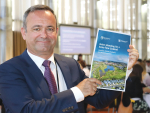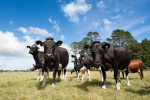Dairy farmers are being told that careful planning in spring is important for successful wintering.
It starts with choosing the right paddocks to grow winter crops in, says DairyNZ South Island lead Tony Finch.
“Choosing your paddocks is a crucial part of planning for winter. Critical source areas, waterways, shelter, water troughs and preparation for prolonged weather events all need to be taken into account when selecting a paddock,” said Finch.
Winter grazing practices in some regions have come under scrutiny.
Farmers in Otago and Southland have endured a campaign by animal right activists, who took photographs of cows in muddy paddocks to highlight poor winter grazing practices.
Finch says critical source areas are low lying parts of a farm such as gullies and swales, where water flows after rain. These areas can transport soil, E.coli and phosphorus into waterways. Paddocks with multiple slopes and large critical source areas are best avoided for winter crop grazing, as they are time consuming to graze and present an environmental risk.
“Strategic grazing and careful management of critical source areas resulted in an 80 - 90% reduction in sediment and phosphorus losses in a 2012-2014 trial at Telford Dairy,” said Finch.
“Creating buffer zones or grass strips in and around critical source areas and next to waterways helps slow water flows and trap contaminants. These buffer zones should be left uncultivated and ungrazed to be effective. The faster water flows in a buffer zone, the wider the zone needs to be.
“There are a number of things to consider when planning how to fence the paddock and position feed and water troughs. Using portable troughs reduces the amount of walking cows need to do, decreasing soil damage and mud.”
Cow lying time is another factor to consider when planning for winter.
“Correct lying times, at least eight hours a day, reduce the risk of lameness and stress on the animal. On a winter break fed paddock, consider how your cows will have access to enough dry areas to lie down,” Finch advised.
“The South Island can experience periods of extreme winter weather, such as snow and heavy rainfall, so it’s essential to have another grazing option. This could involve moving cows to a sheltered area or leaving an ungrazed area next to a shelter belt for bad weather.
“It’s also a good idea to allow a feed buffer in your budget to account for extra feeding on cold, wet or windy days.”
Finch says that, alongside other organisations, DairyNZ has run events over the past few weeks for farmers, rural professionals and rural contractors to upskill themselves on good wintering practices.
“There’s been a lot of focus on winter grazing practices recently. As a result of this, there has been strong attendance at wintering events as everyone is keen to improve their knowledge.
“Successful wintering is good for the cows, the environment and the people involved.”
For more advice on winter grazing go to dairynz.co.nz/wintering


















